President Trump signaled tariffs on Chinese imports would “come down substantially,” though no specifics have yet been released by the White House. The news had stock markets rallying and automakers hoping this could reduce their own burden, analysts previously warning that tariffs could cost the U.S. industry up to 2 million sales this year. But manufacturers are still facing big hits from tariffs on Mexican and Canadian-made autos and auto parts, reports Headlight.News.
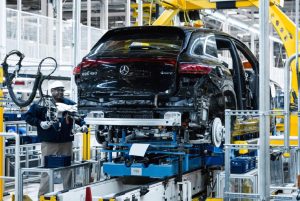
Most vehicles made in the U.S., including this Mercedes-Benz EQS, use at least some Chinese-made parts.
Tariffs on Chinese-made goods could “come down substantially,” Pres. Donald Trump signaled Wednesday, the latest U-turn in his ongoing global trade war.
If the White House follows up that could avert what analysts had warned could be not only a serious surge in consumer prices but a situation in which Chinese-made products start to disappear from American store shelves without replacements in hand.
The auto industry stands to benefit from any reduction in tariffs on Chinese imports “because I don’t think there’s an automaker (producing vehicles) in the U.S. that isn’t sourcing some parts from China,” said Stephanie Brinley, principal auto analyst for S&P Global Mobility. But she cautioned that manufacturers are still facing increased costs that some experts warned could raise costs by thousands of dollars per vehicle.
Trump signals a potential retreat
Since launching his global trade war shortly after his January 20 inauguration, Trump has enacted a number of different sanctions, some targeting specifics sectors, such as foreign-made steel and aluminum, as well as specific countries. He has since pulled back on a number of these, among other things “pausing” the broadest import sanctions and then taking a similar step with tariffs covering foreign-made smartphones and computers.
Now, the president is rethinking what became a tit-for-tat series of escalating tariffs targeting China. Where the broader global sanctions were to vary by trading partner, China’s eventually climbed to 145% and remained in effect while others were paused.
On Wednesday, Trump mt with reporters in the Oval Office and told them “145% is very high and it won’t be that high,” adding, “It won’t be anywhere near that high. It’ll come down substantially. But it won’t be zero.”
China’s response to the Trump hard line didn’t go as smoothly as expected by a president who had said on more than one occasion “trade wars are easy to win.
“Claiming it wants to reach an agreement with China while constantly applying maximum pressure is not the right way to engage with China — and it simply won’t work,” Guo Jiakun, a spokesperson for China’s Foreign Ministry, told reporters at a news conference.
Some relief for the auto industry
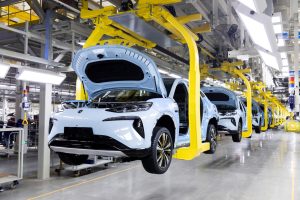
Unless revised, tariffs on Chinese goods – including auto parts – run 145%. Add another 100% for Chinese EVs.
Actually, the situation was worse for the auto industry as the 145% tariffs were on top of prior duties of 100% put in place under former Pres. Joe Biden covering electrified vehicles such as the Chinese-made Volvo EX90.
Even when it comes to auto parts and components, any reduction in tariffs on parts and components would be a significant break for carmakers who, in some cases, have significant Chinese content in their vehicles.
But manufacturers are still bracing for the full impact of Trump’s trade war as other tariffs are still in effect, including those covering vehicles, parts and components imported from Canada and Mexico. Automakers are also paying what translates into a tax on foreign-made steel and aluminum.
And these will wind up adding thousands of dollars to the cost of a new vehicle, according to various studies by the Anderson Economic Group, Cox Automotive, S&P Global Mobility and others. That includes those assembled in the U.S. because all require at least some imported parts and metals.
More tariff news
- Trump Pauses Most Tariffs – But Not Those Impacting Autos
- JLR Pauses Exports to U.S., Blames Tariffs
- Tariffs Helped Slam Tesla Q1 Earnings
Collateral damage

Automotive plans take years to execute – especially shifting production back to the U.S. – said Kia America COO Steve Center.
The president has argued that tariffs are needed to bring more manufacturing back to the U.S. And a number of auto industry officials agree with that goal, at least conceptually. But those who’ve spoken to Headlight.News have also stressed that this isn’t an overnight goal.
“This is an industry that has a multi-year planning horizon,” said Steve Center, chief operating officer for Kia America.
In some cases, local suppliers can be found to replace imports, typically on nuts-and-bolts-level parts, and it may be possible to transfer production of a low-volume nameplate into an underutilized U.S. assembly plant. But starting from scratch, lining up a site, building a factory, then training a production team, can take years, said Center.
In the meantime vehicle prices, driven up by tariffs, could cost as much as 1.8 million units in 2025 alone, forecast Telemetry Research. That, in turn, could wind up costing U.S. jobs. Stellantis earlier this month announced 900 layoffs due to Trump tariffs. Two truck makers, Mack and Volvo, now have made cuts of their own.


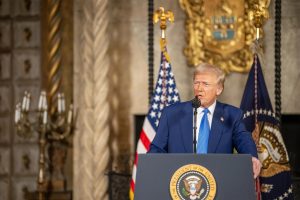

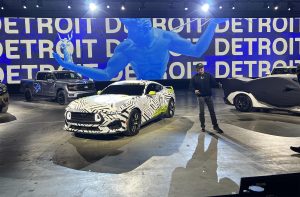
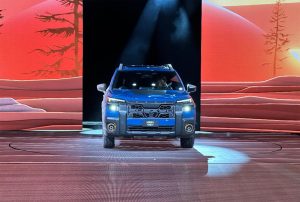
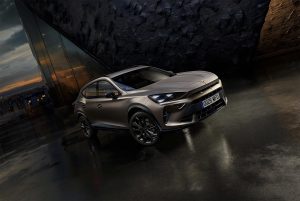
0 Comments